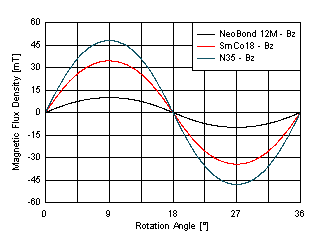SBAA449B October 2020 – October 2021 TMAG5110 , TMAG5110-Q1 , TMAG5111 , TMAG5111-Q1
3.1.2 Magnet Strength
If constrained by placement and required resolution, it may be necessary to use a magnet material with stronger magnetization. In a similar fashion, we can compare the result of our bonded ceramic type magnet with that of N35 and SmCo18 type magnets. The placement beneath the outer edge of the magnet is used again, and only the material type is varied. Notice that the Neodymium type magnet offers a much greater peak amplitude than the molded ceramic magnet with an identical pole count.
 Figure 3-5 Variation of Magnetic Material
Figure 3-5 Variation of Magnetic Material